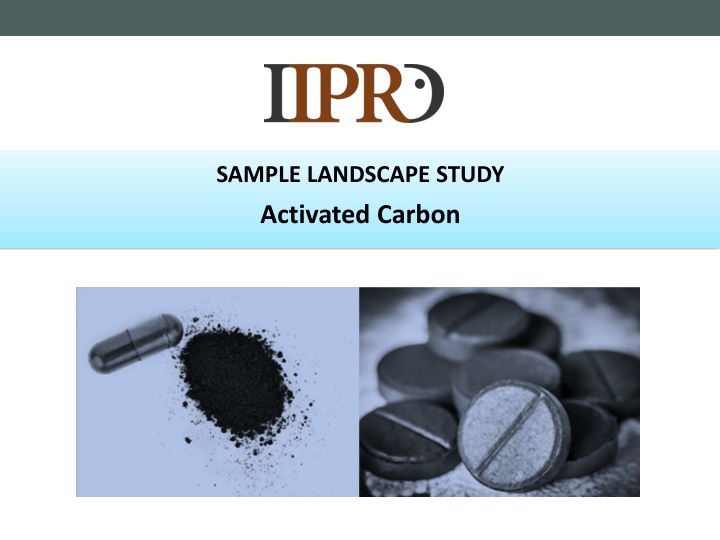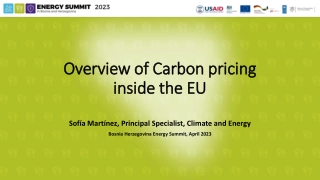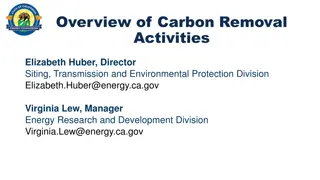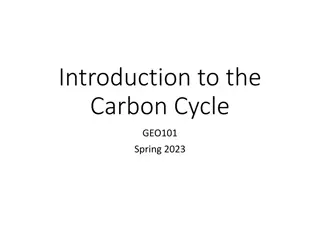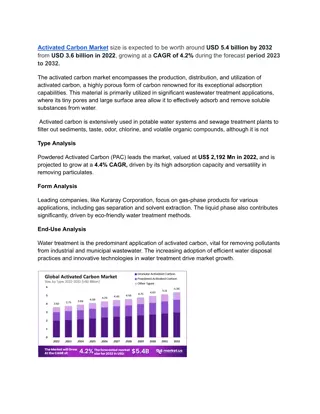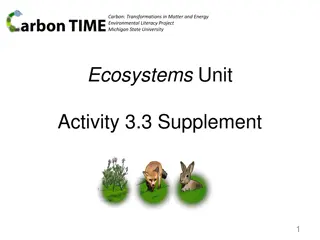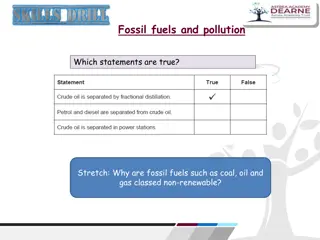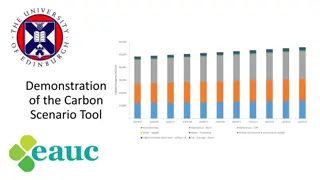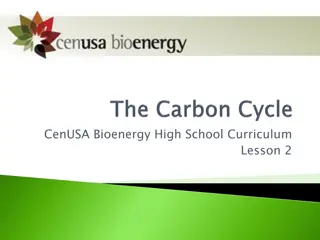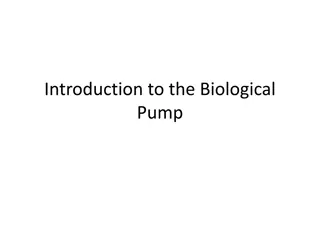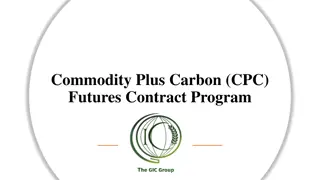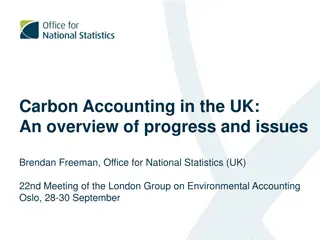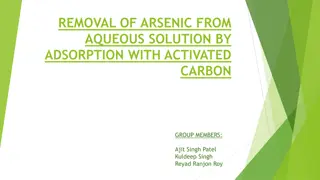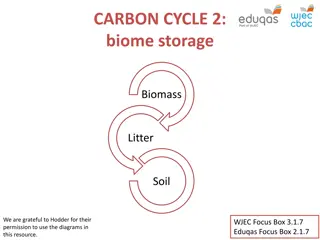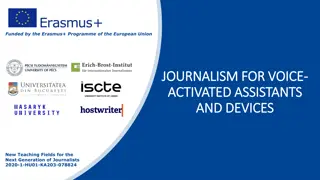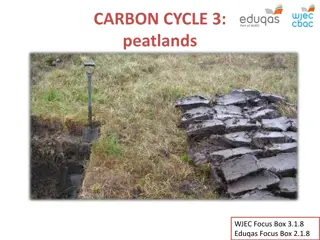Activated Carbon Landscape Study
Activated carbon, a processed carbon-based material with superior adsorptive properties, is analyzed in this landscape study. Explore growth prospects, key technology trends, patent portfolio analysis, and global market insights to make informed decisions in the activated carbon industry. Discover the potential applications, market size, and prominent players in this dynamic sector.
Download Presentation

Please find below an Image/Link to download the presentation.
The content on the website is provided AS IS for your information and personal use only. It may not be sold, licensed, or shared on other websites without obtaining consent from the author.If you encounter any issues during the download, it is possible that the publisher has removed the file from their server.
You are allowed to download the files provided on this website for personal or commercial use, subject to the condition that they are used lawfully. All files are the property of their respective owners.
The content on the website is provided AS IS for your information and personal use only. It may not be sold, licensed, or shared on other websites without obtaining consent from the author.
E N D
Presentation Transcript
SAMPLE LANDSCAPE STUDY Activated Carbon
Contents Introduction to Activated Carbon Growth Prospects Objectives of the Landscape Study Trend Analysis and Graphical Representation Key Technology Trends Patent Portfolio Analysis Technological Dissection of Patent Portfolio and Analysis of Key Granted Patents/ Patent Applications Analysis of Key Granted Patents/ Patent Applications Assigned to Educational Institutes and Universities Appendix A Sources Appendix B Definition of IPC Classes 2
Introduction to Activated Carbon Activated carbon (sometimes called as activated charcoal) is a processed carbon-based material to maximize its adsorptive properties, yielding a superior adsorbent material. Physical and chemical properties of activated carbon varies significantly depending on the source material, and the processing methods used. There are three main types of activated carbon produced: powdered, granular and pelletized or extruded. Activated carbon is generally produced through a two stage process: carbonization and activation. During carbonization the raw material is thermally treated (pyrolysis) in inert environment to remove oxygen, hydrogen, nitrogen, sulfur etc. from the source material. During activation, carbonized materials is oxidized, or treated with oxygen, either by exposure to CO2or steam (physical) or by an acid-base chemical treatment. While selecting an activated carbon for a particular application, variety of characteristics are considered like pore structure, hardness/abrasion, adsorptive properties, apparent density, ash content, pH value, and particle size. The ability to adsorb components from a liquid or gas makes activated carbon useful in water purification, air purification, recovery of precious metals such as gold and silver, electrodes in super capacitors, and such other myriad of applications. 3 For sources of information, please refer to Appendix 1
Growth Prospects The global activated carbon market size was estimated at USD 4.72 billion in 2018 and is expected to expand at a CAGR of 17.5% during the period 2019-2025 with increasing demand in super capacitors, water treatment, and sewage treatment applications to be key growth drivers. Activated carbon is extensively used in water and sewage treatment owing to its ability to remove particulate and dissolved impurities. It also eliminates certain organic impurities and removes chlorine from water. The United States Environmental Protection Agency (EPA) and government regulatory agencies have recommended activated carbon as the best available material for removing chemical impurities such as mercury. It is a critical time to understand the global competitive environment of activated carbon from a patent perspective, and in-depth patent analysis of key technologies & players can help anticipate changes, detect business opportunities, mitigate risks, and make strategic decisions to strengthen one s market position and maximize return on one s IP portfolio. Some of the prominent participants in the global market of activated carbon are Cabot Corporation, Jacobi Carbons AB, Calgon Carbon Corp., Osaka Gas Chemical Co. Ltd., and Evoqua Water Technologies LLC. 4 For sources of information, please refer to Appendix 1
Objectives of the Landscape Study To understand technology and prepare patent landscape. To understand major patent holders, geographical distribution of patents, top sub- technologies based on IPC codes. Analysis of patent filing trends over the years, top assignees, top patent classifications, among others. To conduct Patent Portfolio based study of patents relating to core focus area of activated carbon. The instant sample report provides patent analysis for activated carbon for various industries like super capacitors, water purification or sludge treatment, air filters, medicinal and food & beverages, for functional and technical features of the materials and advanced technology based patents. Time-lines: The landscape study focuses on patents pertaining to activated carbon filed between 2009-2019. 5
Trend Analysis and Graphical Representation 6 Patent Searching | Research and Analytics | Patent Prosecution/Preparation Support | Litigation and E-Discovery | IP Valuation | Patent Portfolio Watch
Filing Trends Last 10 Years JP US KR CN PL DE Others 4%3%8% 25 23 34% 21 14% 20 20 Number of Patent Families 17% 15 20% 15 11 10 10 10 8 7 8 5 0 2009 2010 2011 2012 2013 2014 2015 2016 2017 2018 Application Year Insights Global patent filing trend analysis shows an overall rise in the number of patent applications filed during last 10 years. There is significant rise in the number of patents filed during the period 2015-17 with highest number of filings in the year 2018. Maximum number of patent applications were filed from JP. # Filing trends for year 2017-2018 may be higher than that reflected in the above graph, attributed to unpublished patent applications. 7
Publication Trends - Last 10 Years 38 40 35 Number of Patent Families 30 25 20 20 16 13 15 9 9 8 11 10 5 3 5 1 0 2009 2010 2011 2012 2013 2014 2015 2016 2017 2018 2019 Publication Year Insights Global patent publication trend presents an overall rise in the number of publications during last 10 years with its peak during 2018 suggesting significant filing during the period 2015-2017. # Publication trends for year 2019 may be higher than that reflected in the above graph, attributed to unpublished patent applications. # Graphs were prepared based on the publication year of the priority application 8
Top Assignee 6 5 5 5 4 4 4 No of patent families 4 3 3 3 3 2 0 Assignee Insights Korea Inst of Ceramic Engg & Tech, Zachodniopomorski Univ and Jx Nippo Oil & Energy Corp, are the leading patent applicants/assignee in the domain. 9
Top International Patent Classifications (IPCs) IPC Sub Class Distribution C01B C01B003230 , 14% B01J, 11% C01B0032336 , 9% C01B003108 , 18% Others, 8% C01B, 74% C01B003112 , 9% C01B0032312 , 24% Others, 21% H01G, 7% C01B0032342 , 5% Insights Highest number of applications filed during 2009-2019 corresponds to IPC class C01B . Majority of patent applications were assigned with IPC C01B-31/08 followed by IPC C01B-32/30 and C01B-32/312 10 # For IPC sub-class definitions please refer to Appendix 2.
Geographical Origin of Innovation Others 11 DE 4 PL 6 Jurisdiction CN 18 KR 22 US 27 JP 45 0 10 20 30 40 50 60 70 Number of Patent Families Insights Analysis of Geographical Origin of Innovation (i.e. Priority Country) demonstrates that maximum number of innovations originated from JP followed by US, KR and CN jurisdictions. # The graph representing Geographic origin of innovation was prepared based on the analysis of priority country member 11
Key Technological Trends 12 Patent Searching | Research and Analytics | Patent Prosecution/Preparation Support | Litigation and E-Discovery | IP Valuation | Patent Portfolio Watch
Type of Activated Carbon Pelletized, 6% Other, 3% Granular, 23% Powder, 68% Insights Highest number of patent applications (63%) were focused on powdered activated carbon while 23% of patent applications were related to granular activated carbon. 13
Raw Materials Employed for Activated Carbon Production Sub dissection of Bio/Natural Sources Other, 11% Cellulose based, 33% Coconut based, 10% Carbon/Coke Based, 19% Bio/Natural sources, 58% Polymers, 12% Coal based, 18% Others, 39% Insights Highest percentage of applications (58%) were related to use of bio/natural sources as raw materials for activated carbon production with Cellulose biomass as the major type of bio/natural source based raw material. 14
Application Area Other , 18% Water Purification, 12% Super Capacitors, 52% Air Purification, 18% Insights Majority of the patent applications (52%) disclosed application of activated carbon in super capacitors followed by application in air purification (18%) and water purification (12%). 15
Patent Portfolio Analysis 16 Patent Searching | Research and Analytics | Patent Prosecution/Preparation Support | Litigation and E-Discovery | IP Valuation | Patent Portfolio Watch
Patent Portfolio Analysis JX Nippon Oil & Energy Exploration Company Profile JX Nippon Oil & Energy Corporation is Japan based company dealing in refined carbon materials and petrochemical products. It is also actively engaged in importing and selling of gas & coal and supply of electricity & hydrogen. Activated Carbon Type Raw Materials Used Application Area Granular, 20% Bio/Natural sources, 25% Other, 25% Super Capacitors , 100% Powder, 80% Carbon/Coke Based, 50% 17
Patent Portfolio Analysis JX Nippon Oil & Energy Exploration Key Patents Patent No. Key Features US7741389B2 Resin composition containing a polyalkylene furan dicarboxylate resin and a porphyrin compound US8981037B2 PEF used in preparation of a polyester resin The patent document disclose a process for producing uniform sized powdered activated carbon with large specific surface area suitable for an electric double layer capacitor electrode. The process comprises carbonizing the petroleum coke or coal coke raw material US8664155B2 US20120258299 PEF is used in preparation of a polyester resin under an oxidizing gas atmosphere preferably mixture of air and nitrogen. The use of CANON the activated carbon produced by the process of the present invention in an electrode can provide an electric double layer capacitor having a large capacitance per unit volume. The patent document discloses a method for producing activated carbon from cellulose raw material. The method comprises the step of carbonization cellulose under an inert atmosphere JP2017135154A to obtain a carbonized substance and mixing the carbonized substance with sodium hydroxide or potassium hydroxide and a phosphorus compound to obtain a mixture. The mixture is crushed and activated under the inert atmosphere to obtain the activated carbon 18
Patent Portfolio Analysis Osaka Gas Chemicals Co Ltd Company Profile Osaka Gas Chemicals Co., Ltd. produces activated carbon with higher performance and special applications like air and water purification, food & beverages, medical, etc. The company develop, manufacture and sell materials and components to manufacture products in different fields such energy, environment and electronics. Activated Carbon Type Raw Materials Used Application Area Super Capacitors, 25% Granular, 50% Bio/Natural sources, 100% Powder, 50% Water Purification, 75% 19
Patent Portfolio Analysis Osaka Gas Chemicals Co Ltd Key Patents/Publications US7741389B2 Resin composition containing a polyalkylene furan dicarboxylate resin and a porphyrin compound Patent No. Key Features US8981037B2 PEF used in preparation of a polyester resin The patent document provide a granular activated carbon and it s manufacturing method from coconut shell raw material. The granular activated carbon is obtained by carbonizing the raw material and then pulverized. The pulverized product is then mixed with a calcium component and US20120258299 PEF is used in preparation of a polyester resin US9802824B2 molded. The molded product is activated under stream and temperature range of about 800 to CANON 1,000 C followed by washing. The activated carbon can be used for purification of catalyst supports. The patent application relates to manufacturing of activated carbon with excellent filtration capability of trihalomethanes from tap water even at high altitudes. The method of manufacturing WO2018116859A1 comprises activating the raw material at a temperature of 900 ~ 1000 C under CO2 atmosphere. The preferred raw material used in the invention is coal pitch. 20
Analysis of Key Granted Patents/Patent Applications Assigned to Educational Institutes, Universities and Other Companies 21 Patent Searching | Research and Analytics | Patent Prosecution/Preparation Support | Litigation and E-Discovery | IP Valuation | Patent Portfolio Watch
Granted Patents/Patent Applications Korea Institute of Ceramic Engineering & Technology Patent No. Key Features US7741389B2 Resin composition containing a polyalkylene furan dicarboxylate resin and a porphyrin compound US8981037B2 PEF used in preparation of a polyester resin The patent document relates to the manufacture of partially crystalline porous activated carbon from wood based biomass raw material. The raw material is carbonized under inert KR1944247B1 atmosphere and immersed in a alkali solution (KOH or NaOH). The carbonization material is activated under inert atmosphere and washed the dried product to obtain partially US20120258299 PEF is used in preparation of a polyester resin EP2257596B1 Resin composition containing polyethylene furandicarboxylate crystalline active carbon which can be used in the super capacitors. CANON The patent document relates to a method of manufacturing of porous activated carbon having a nitrogen containing functional group with high specific surface area. The activated EP2235100B1 Resin composition containing polyethylene furandicarboxylate carbon showing a high specific capacitance and can be used as a electrode material in super US20090124763 Method of synthesis, PEF having a furan ring KR101660297B1 capacitors. The method comprises carbonization of ionic liquid containing nitrogen as raw material with alkali (KOH/NaOH) at temperature range of 500~1000 under inert atmosphere. 22
Granted Patents/Patent Applications Zachodniopomorski Uniwersytet Technologiczny w Szczecinie Patent No. Key Features The patent document relates to a method for manufacturing activated carbon from cotton. US7741389B2 Resin composition containing a polyalkylene furan dicarboxylate resin and a porphyrin compound US8981037B2 PEF used in preparation of a polyester resin The method comprises adding cotton material to an activator solution and drying the resulting mixture. KOH and / or Na2CO3, and / or K2CO3 are used as activators. The PL419638A1 carbonization is done in an inert gas atmosphere at a temperature of 500-1000 C. The resulting product was washed with distilled water to obtain activated carbon. The resultant US20120258299 PEF is used in preparation of a polyester resin EP2257596B1 Resin composition containing polyethylene furandicarboxylate activated carbon can be used for air purification systems. CANON The patent document relates to a method for producing activated carbon which comprises mixing in a source of the dried activated carbon with an aqueous activator solution. mistletoe leaves are used as source of activated carbon and KOH and / or NaOH and / or EP2235100B1 Resin composition containing polyethylene furandicarboxylate ZnCl 2 and / or Na2CO3, and / or K2CO3, are used as activators. The resulting mixture is US20090124763 Method of synthesis, PEF having a furan ring PL419186A1 carbonized in an inert gas atmosphere chemically washing and drying at a temperature of 400 - 1000 C for 1 - 5 hours. After cooling, the carbonization, the product obtained is washed with distilled water until neutral, treated with hydrochloric acid and again washed with distilled water until neutral, and the obtained active carbon is dried. The resultant activated carbon can be used for CO2 absorption in air purification systems. 23
Granted Patents/ Patent Application Other Companies Patent No. Key Features The patent document discloses a method for producing the activated carbon with reduced JP2013023405A Kansai Coke & Chemicals US7741389B2 Resin composition containing a polyalkylene furan dicarboxylate resin and a porphyrin compound silicon content for an electric double-layer capacitor electrode. The method comprises US8981037B2 PEF used in preparation of a polyester resin a carbon raw material paper phenol resin laminate is treated with an alkaline solution having a alkali metal hydroxide and activated followed by steam activation. The patent document discloses a method for producing activated carbon. The method comprises the heat treatment of raw material ashless coal at a temperature below 800 C in an EP2257596B1 Resin composition containing polyethylene furandicarboxylate CANON JP2012101948A Kansai Coke & Chemicals inert atmosphere and mixing with an alkali activating agent and subjecting the mixture to activation treatment at a temperature of 600 C or higher and 950 C or lower to get activated carbon. The resulting activated carbon can be used as electrode materials in electric EP2235100B1 Resin composition containing polyethylene furandicarboxylate double layer super capacitors. The patent document relates to a manufacturing method of activated carbon from different EP2252645B1 Polyester resin used for producing a molded article raw materials like coconut shell, phenol resin, coal, carbon materials such as rayon. The JP6371787B2 Kansai Netsukagaku carbonized material is activated through steam activation method to get the activated carbon. The resultant carbon material can be used as a electrode material in electric double layer super capacitors. 24
Appendix 1: Sources https://feeco.com/introduction-to-activated-carbon/ https://www.thomasnet.com/articles/chemicals/producing-activated-carbon https://www.grandviewresearch.com/industry-analysis/activated-carbon-market https://businessherald.co/activated-charcoal-market-2018-2024-with-strategic-trends-growth- revenue-demand-future-potential-of-industry/ https://www.alliedmarketresearch.com/activated-carbon-market https://www.chemviron.eu/products/activated-carbon/ https://www.jurassiccarbon.com/blogs/news/12186281-the-history-of-activated-carbon https://www.sciencedirect.com/science/article/pii/S1876619616000991 A review on activated carbon: process, application and prospects https://www.sciencedirect.com/science/article/pii/S095965261732989X https://www.ncbi.nlm.nih.gov/pmc/articles/PMC1306980/ 25
Appendix 2: Definition of IPC Classes IPC DEFINITION US7741389B2 Resin composition containing a polyalkylene furan dicarboxylate resin and a porphyrin compound US8981037B2 PEF used in preparation of a polyester resin CHEMICAL OR PHYSICAL PROCESSES, e.g. CATALYSIS OR COLLOID CHEMISTRY; THEIR RELEVANT APPARATUS B01J C01B NON-METALLIC ELEMENTS; COMPOUNDS THEREOF US20120258299 PEF is used in preparation of a polyester resin CANON ACTIVE CARBON C01B 32/30 PREPARATION C01B 32/312 EP2235100B1 Resin composition containing polyethylene furandicarboxylate US20090124763 Method of synthesis, PEF having a furan ring C01B 32/336 CHARACTERIZED BY GASEOUS ACTIVATING AGENTS EP2252645B1 Polyester resin used for producing a molded article C01B 32/342 CHARACTERIZED BY NON-GASEOUS ACTIVATING AGENTS 26 Patent Searching | Research and Analytics | Patent Prosecution/Preparation Support | Litigation and E-Discovery | IP Valuation | Patent Portfolio Watch
Disclaimer IIPRD has prepared this sample report as an exemplary report, wherein the content of the report is based on internal evaluation of Patents and Non-Patent Literature that is conducted based on Databases and Information sources that are believed to be reliable by IIPRD. A complete list of patent documents retrieved is not disclosed herein as the report is exemplary but can be shared if desired based on terms and conditions of IIPRD. IIPRD disclaims all warranties as to the accuracy, completeness or adequacy of such information. The above sample report is prepared based on the search conducted on the keywords and other information extracted from the understanding of the Patent Analysts of IIPRD, and subjectivity of the researcher and analyst. Neither IIPRD nor its affiliates nor any of its proprietors, employees (together, "personnel") are intending to provide legal advice in this matter. 27
ContactDetails CONTACT DETAILS Noida (NCR) Office Head Office E-13, UPSIDC Site-IV, Behind Grand Venice, Greater Noida, 201310 Contact Person: Tarun Khurana Contact No(s):+91-(120) 4296878, 4909201, 4516201 E-Mail: iiprd@iiprd.com, info@khuranaandkhurana.com Website: www.iiprd.com | www.khuranaandkhurana.com Delhi | Noida | Mumbai | Pune | Bangalore | Hyderabad | Indore | Jalandhar | Chennai US | Bangladesh | Myanmar | Vietnam | Nepal | Sri Lanka | Malaysia 28
About IIPRD IIPRD is a premier Intellectual Property Consulting and Commercialization/ Licensing Firm with a diversified business practice providing services in the domain of Commercialization, Valuation, Licensing, Transfer of Technology and Due-Diligence of Intellectual Property Assets along with providing complete IP and Patent Analytics and Litigation Support Services to International Corporate and Global IP Law Firms. 29 Office- E-13, UPSIDC, Site-IV, Kasna Road, Greater Noida, National Capital Region - 201310, India ,Phone: +91.120. 4296878, 4909201, 4516201 Fax: 2342011, Website: www.iiprd.com, Email: iiprd@iiprd.com
